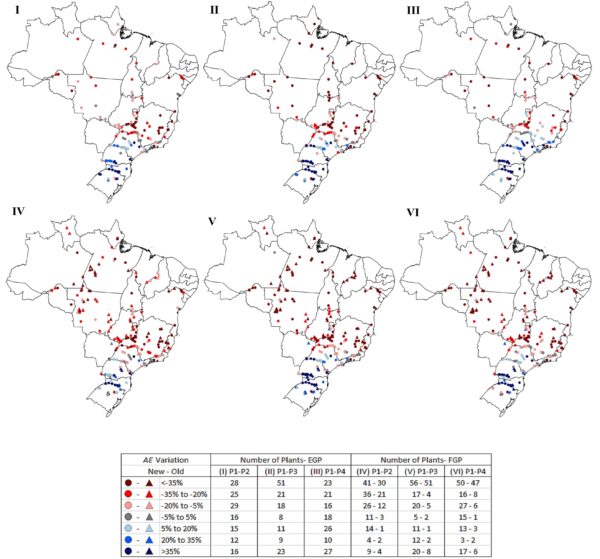Climate change impact in hydro-dominant power system
In this work, we evaluate the impacts of climate change in the revenues of hydropower plants in Brazil. One important input for designing and evaluating investment opportunities in hydropower is the water inflows historical data. Unfortunately, the use of such information alone may not project well the future power generation due to the influence of climate change in the water inflow patterns. This paper introduces spatio-temporal information of the future climate into the operational planning of the Brazilian hydropower system. Global climate models from IPCC are considered along with downscaled regional climate models. Our results at the individual hydro plant level show the importance of taking into account climate change information when performing hydro generation planning studies.
The figure below shows the variations of Assured Energy between the four periods investigated 1961-1990 (P1), 2011-2040 (P2), 2041-2070 (P3), and 2071-2100 (P4), and two configurations of the electrical system, EGP, and FGP. The EGP considers only the existent hydro plants in the configuration of the ISO monthly operation program from January 2012. The FGP considers all hydro plants previously mentioned and other plants planned to enter the system until 2030. In the EGP (FGP) there are 141 (214) hydro plants and an installed capacity of 107 (143) GW. The existent hydro plants are represented by circles and the new hydro plants are represented by triangles.

In Brazil the Assured Energy works as ballast for energy sales in the electricity market, thus its reduction or increase has a direct impact on the hydro plant’s revenue. Some important conclusions can be derived from this figure. First, the plants in the south region of Brazil tend to benefit from climate change, on the other hand, many plants in the Noth and Central region of Brazil are expected to face substantial losses. Another interesting aspect is that many of the new hydro plants are expected to have reductions in its Assured Energy, this is due to two facts: (1) future water inflows in the North and Northeast regions are heavily affected by changes in climate; (2) new hydro plants (located in the North) are mostly run-of-river and therefore more susceptible to variations in water inflows.
Related Publications:
- AR de Queiroz, VAD Faria, LMM Lima, JWM Lima. Hydropower revenues under the threat of climate change in Brazil. Renewable energy, 2019.